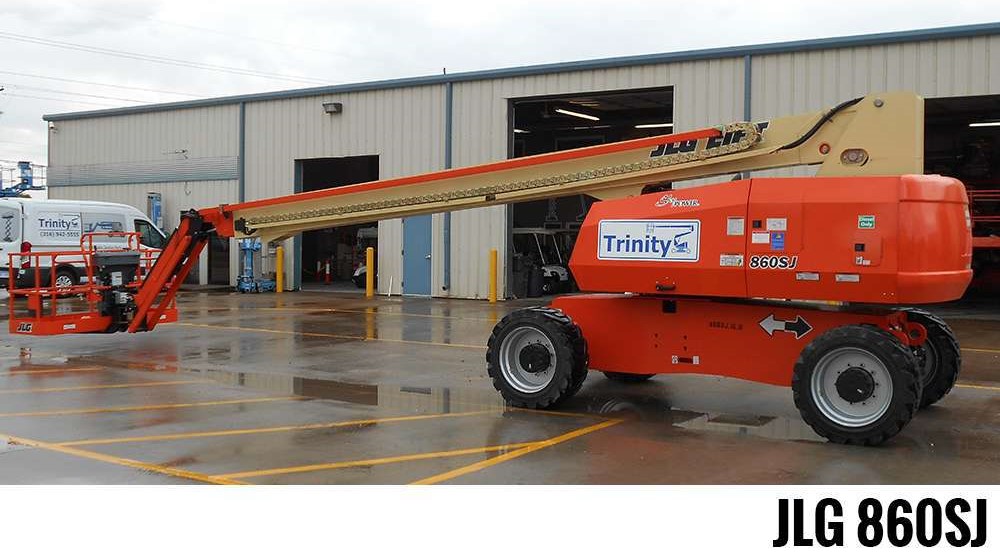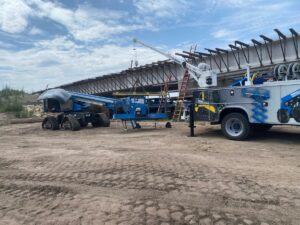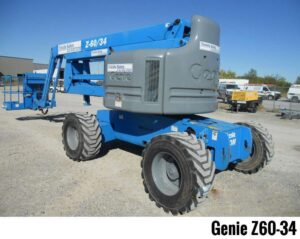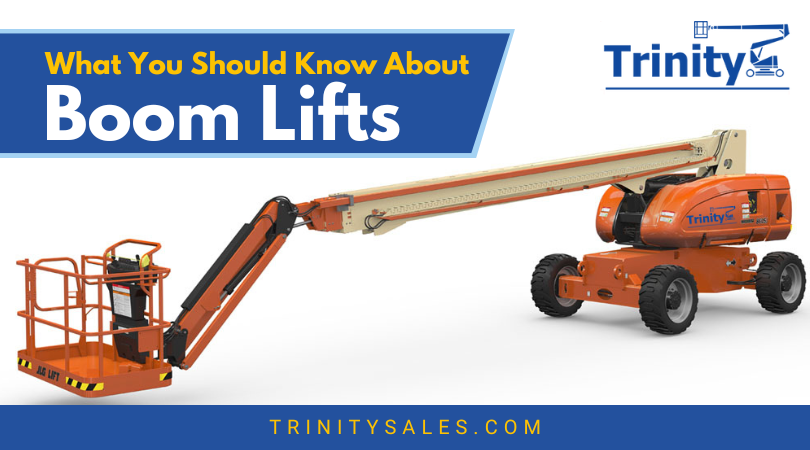
A boom lift is a type of aerial lift used to transport workers on construction sites, farms, along utility lines, and other spots. It is made up of a platform or bucket that is connected to a hydraulic arm and a grounded, movable base. Boom lifts can be used by lift operators to lengthen their vertical or horizontal reach or to work at an angle in complex workspaces. Boom lifts from Trinity Sales and Rental in Wichita, KS are a great option in Kansas and Oklahoma for your commercial or industrial construction project.The Basics of Boom Lift
A boom lift’s primary components are a platform or bucket with a long arm attached to a grounded base. A hydraulic lift system controls the arm, allowing it to extend out and up to carry people or materials to new heights.
Boom lifts are classified into two types: articulating boom lifts and telescopic boom lifts. Telescopic boom lifts have straight arms, whereas articulating boom lifts have bent arms. Telescopic boom lifts have greater weight capacities, whereas the bending ability of an articulating boom lift makes moving the bucket around objects easier.
Boom Lift VS Scissor Lift
The scissor lift is another type of lift. A scissor lift moves only up and down, whereas a boom allows for a forward reach and can provide more flexible movement at a height depending on the arm type.
In situations like these, you might prefer to use a scissor lift rather than a boom lift:
- Lifting containers into a warehouse’s upper shelves or removing them (electric scissor lifts can be used in this situation)
- Cleaning the windows on a building’s side
- Workers are lifted on job sites with rough terrain
- Elevating a large number of workers and bulkier materials
The Uses of Boom Lift
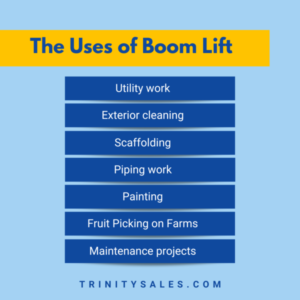
Boom lifts can be used on numerous job sites related to construction, maintenance, agriculture, and other industries. Specific applications include:
- Utility work
- Exterior cleaning
- Scaffolding
- Piping work
- Painting
- Fruit Picking on Farms
- Maintenance projects
Contractors use a boom lift whenever a project requires work at a height. Increased stability, mobility, and capability increase the safety of workers working at heights and can help make a project safer and more efficient.
Advantages of Boom Lift
Boom lifts can reach higher and farther than other types of lifts, such as scissor lifts, making them ideal for high-rise construction, bridge work, and other projects that require maximum reach.
Maneuverability-Conveying boom lifts, in particular, can provide access to previously inaccessible work areas.
Height-With a reach of up to 210 feet, they can reach up to 17 stories high, far higher than a scissor lift.
Platform options-Depending on your priorities, narrow or wide platforms can accommodate more capacity or fit in tighter spaces.
Fuel options-Depending on the power source, you can choose an electric or diesel boom lift that can work indoors or outdoors.
While boom lifts have many advantages, they also have some drawbacks. They have a smaller platform with a limited weight capacity, so they may not be suitable if you need to raise several workers or heavy materials.
Types of Boom Lifts
Different jobs require different types of boom lifts. Indoor jobs in warehouses, for example, may involve a quiet, zero-emissions electric lift, whereas an outdoor job requiring more power may necessitate a diesel dual-fuel lift. There are also various configurations.
Articulating Boom Lifts
Articulating boom lifts have arms with multiple joints, similar to a finger, which is why they are also known as knuckle lifts. These joints allow them to reach over and around obstacles in confined spaces, enabling workers to reach areas that would otherwise be inaccessible.
Bucket Truck
A bucket truck is a heavy-duty wheeled vehicle that is frequently used in tasks such as orchard work (hence the nickname cherry picker) and utility line maintenance. It has a railed aerial platform connected to a hydraulic crane.
Telescopic Boom Lifts
Telescopic boom lifts have an arm that stretches and contracts in a single direction, similar to a telescope. The arm is connected to a rotating turntable and can expand straight up or at an angle; the bucket at the end usually holds one worker at a time.
Choosing The Best Lift For Your Job
When you’ve decided that a boom lift is the best option for your project, you’ll need to figure out which model is best for you. Do you require a machine with a higher lift height, a larger weight capacity, or a longer horizontal reach? How much does cost play a role? Do you require an electric boom lift for inside work or a diesel man lift for outside work?
Terrain
The type of terrain you’re working on in Kansas or Oklahoma can also influence the kind of boom lift you require.
- Some models of articulating boom lifts work great on flat, stable ground, which can prevent unsteadiness and potential tipping. Even so, articulating boom lifts with rough or uneven terrain capabilities are also available.
- Bucket truck: Because of its low center of gravity and heavy-duty tires, it is ideal for uneven, rough terrain.
- Telescopic boom lift: Some, like articulating lifts, work best on flat, stable ground, but rough terrain lifts that can access uneven, rough terrain are available.
Height
What kind of lift you require will be determined by how high you want to go.
- Knuckle lifts can reach heights of up to 150 feet with an articulating boom lift.
- A bucket truck has a similar range, ranging from 30 to 160 feet.
- Telescopic boom lift: This straight boom has the longest range, extending from 30 to 210 feet.
Workers
Boom lift buckets typically hold one or two people, though some have a slightly larger capacity than others.
- Articulating boom lifts are ideal for one-person jobs.
- Bucket trucks can accommodate one or two people and are versatile depending on the nature of the job.
- Telescopic boom lifts: These can also cater one or two workers.
Direction
When it comes to reaching an elevated work site, different lifts provide a range of choices in terms of directionality.
- Articulating boom lifts can stretch their arms vertically or horizontally, and they can also bend to maneuver their buckets around obstructions.
- Bucket truck arms have a single joint that allows them to move horizontally and vertically.
- Telescopic boom lifts do not have joints, but their hydraulic arm is mounted on a rotating base and can extend up or out in any direction.
Location
In addition to whether they are powered by electrical or diesel fuel, different boom lifts have various configurations that make them more suitable for indoor or outdoor use.
- Articulating boom lifts can be used indoors and outdoors, but their jointed arms make them ideal for tight indoor spaces.
- Bucket truck: These are vehicles that are only used outside.
Telescopic boom lift: Telescopic lifts can be used both inside and outside, but because of how much less compact their straight arms are than articulating lifts, they are less likely to fit comfortably inside of buildings.
Potential Dangers and Safety Procedures
A lift elevates the operator and worker above the ground. Falls are one of the four fatal construction accidents identified by OSHA. Working at heights should be taken seriously, and a worker should never become too accustomed to working above ground.
The boom itself poses potential hazards and, like any heavy equipment, should be handled with caution. Never operate a boom lift unless it is safe to do so, and always wear a protective gear.
Apart from falling, there are only a few common hazards associated with boom lifts. Tipping, pinning, dropped objects, and electricity is all involved.
The Risks of Tipping a Boom Lift
When a machine elevates material – or in this case, people – into the air, the center of gravitational attraction shifts. Boom lifts are extremely stable machines designed to reach out and lift materials and people. But this does not imply that they are exempt from tipping.
Always survey the job site before beginning work and test to ensure the terrain is solid, especially after rain or a storm. Wheels can become stuck or sink, potentially tipping the machine or knocking the operator off. Always use personal protective equipment (PPE) and never exceed the maximum weight and range of a boom lift.
The Risks of Being Pinned or Crushed While Operating a Boom Lift
Boom lifts are to take operators to new heights, but obstacles can be found in the rafters. Overhead frames, traveling against walls, and working under roofs pose a pinching hazard.
Always keep your arms and legs within the safety railings to avoid pinching. Move the bucket gently and never along.
The Risks of Being Pinned or Crushed While Operating a Boom Lift
Boom lifts are to take operators to new heights, but obstacles can be found in the rafters. Overhead frames, traveling against walls, and working under roofs pose a pinching hazard.
Always keep your arms and legs within the safety railings to avoid pinching. Move the bucket gently and never along.
The Dangers of Using Electricity on Boom Lifts
Working at tall heights frequently entails working on electrical projects or near live wires. Electricity is both silent and lethal. Electric workers are aware of the dangers, but those who are not used to working near electricity may overlook or be unaware of them.
Evaluate the placement of electric wires in advance by reviewing site plans. Always treat wires with care.
Other Tips for Staying Safe on a Boom Lift
Choose the Best Boom Lift
- If you’re unsure what equipment you’ll need, consult the experts at Trinity Sales & Rental.
- Ensure you are familiar with and follow the OSHA regulations for the selected machine.
Before Using the Equipment, Double-Check it.
- Check the oil and other fluid levels, wheels, batteries, controls, brakes, and steering before each shift.
- Check for worn parts and make sure all electrical components are working well.
- Repair any issues before attempting to use the equipment.
Use the Equipment Safely
- Boom lifts should be kept at least 10 feet away from live power lines and other potential hazards.
- Consider the combined weight of the worker(s), tools, and equipment when calculating loads, and avoid overloading your platform.
- Wear safety gear such as hard hats, body belts, reflective vests, eye protection, face masks, and gloves.
When winds exceed 28 mph, do not use boom lifts or other MEWPs (mobile elevating work platforms).
Once you’ve committed to a project and decided on what you want to spend, you’re all set to start thinking about the equipment you’ll need. Whether you’re looking for a telescopic boom lift, articulating boom lift, bucket truck, or scissor lift, you’re sure to find rental options that will fit your needs and budget.
At Trinity Sales & Rental, we have offered construction equipment Rental, Sales, and Repair to Wichita and Kansas for over 35 years. Our experts are here to help you with all your construction equipment needs! We’re here to make your construction project run quickly and efficiently. Reserve your equipment today and contact us for more details. You may also call us at 316-942-5555. We can’t wait to hear from you.

